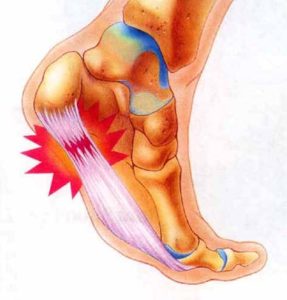 Plantar Fasciitis is the most common cause of heel pain. The condition occurs when tears develop along the long fibrous plantar fascia ligament at the bottom of the foot, resulting in inflammation and pain. The plantar fascia ligament is made of fibrous bands of tissue running between the heel bone and toes. It stretches with each step, causing continued inflammation and pain.
Plantar Fasciitis is the most common cause of heel pain. The condition occurs when tears develop along the long fibrous plantar fascia ligament at the bottom of the foot, resulting in inflammation and pain. The plantar fascia ligament is made of fibrous bands of tissue running between the heel bone and toes. It stretches with each step, causing continued inflammation and pain.
There are a number of causes of plantar fasciitis. Among the most common cause is an overload of physical activity or exercise. The plantar fascia ligament is like a rubber band. It loosens and contracts with movement, and absorbs significant weight and pressure. Athletes commonly suffer from plantar fasciitis as they are particularly prone to it. Excessive running, jumping, or other activities can easily place repetitive or excessive stress on this tissue and lead to tears and inflammation. The result is usually moderate to severe pain.
Another major cause of plantar fasciitis is wearing incorrect shoes. Often, shoes either do not fit properly, or provide inadequate support or cushioning. Other common causes of plantar fasciitis include excessive standing and running, and loss of foot arch.
Several studies have shown ESWT to be an effective treatment for plantar fasciitis. One study treated 79 patients (85 heels) with plantar fasciitis. At the one-year follow-up, the results were as follows: 75.3% complaint free, 18.8% significantly better, 5.9% slightly better, and none were unchanged or worse. The recurrent rate was only 5%. Wang CJ Chen HS, Huang TW. Shockwave therapy for patients with plantar fasciitis: a one-year follow-up study. Foot Ankle Int. 2002;23(3):204-7.
Another study measured success rate and pain relief after very conservative ESWT treatment one time a week for six weeks. The long term success rate (2 years) – 85.7% experienced Excelled or Good results. On a pain scale of 1-10, the average pre-treatment score was 6.5. After 6 weeks, the average score was 2.0. After 2 years, the average score was 1.5. Park JW, Yoon K, Chun KS, et al. Long-term outcome of low-energy extracorporeal shock wave therapy for plantar fasciitis: comparative analysis according to ultrasonographic findings. Ann Rehabil Med. Aug 2014;38(4):534-540.
Another study measured pain before treatment and 6 months post treatment. 93% of patients had “significant improvement” in pain relief. The Surgeon : Journal of the Royal Colleges of Surgeons of Edinburgh and Ireland 2003;1:290-2.
Make An Appointment
